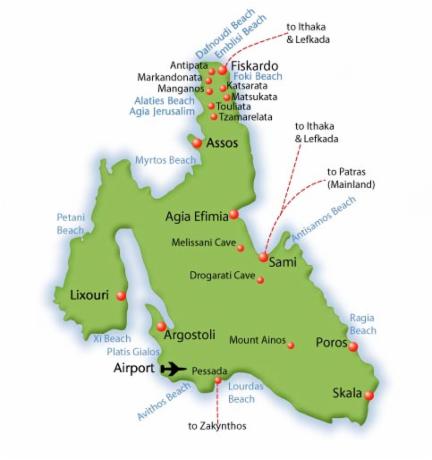
the Ionian islands in western Greece. It occupies an area of 350 square miles and divided into eight municipalities.
- Argostoli
- Lixouri
- Sami
- Erisos
- Eleios-Pronnoi
- Livathos
- Omala
- Pylaros
- Drapano Bridge - 650 meter stone bridge
- Archaeological Musuem of Kefalonia - Mycenaean, Helenistic, Roman period collections
- Korgialenios History and Folklore Museum - Island photos housed in a replicated traditional Kefalonian house
- Korgialenian Library
- Theatre of Kefalos
- Lighthouse of Saint Theodore
Lixouri is the second largest town in Kefalonia. Quiet and friendly, it is situated on the Paliki peninsula. Surrounded by mountains, Lixouri is built around a port that bustles with boats departing to Argostoli. Plateia Petritsi offers its visitors local color through its cafes and restaurants.
Additional attractions:
- The Public Library - Iakovatos family mansion home to icons, manuscript Gospels, vestments and pectoral crosses
- The archaeological collection of Lixouri - Classical and Hellenistic period pottery
- Churches: Agia Triada, Pantocrator, Agios Nikolaos ton Xenon, and Agios Nikolaos Miniation
Beaches: Lepada, Xi and Mega Lakos
The largest harbor on Kefalonia and third largest town, Sami offers daily trips to Patras, Ithaca and Italy. Known also as one of the four powerful ancient cities you will find many preserved remains; Cycolopean walls, Hellenistic fortifications, and ruins.
Additional attractions:
- Karavomilos Lake - mixture of fresh water and sea water from Katavothres Argostoli sink holes
- Drogarati Cave - rare geological phenomenon of stalactites and stalagmites dating thousand of years
- Melissani Lake - deep blue cave lagoon
- Monastery of Agrilia - monastery dedicated to the Holy Virgin
Beaches: Paliouras, Antisamos
The town of Erisos gives us the fishing villages of Fiscardo and Assos. Left minimally damaged from the earthquake of 1953, Fiscardo's charm comes from its many preserved traditional Greek and Venetian dwellings. Assos lends itself similarly as a charming small village. Here you may visit the ruins of a 16th century Venetian castle, admire the traditional architecture, or enjoy the taverns overlooking the bay.
- Venetian Lighthouse and Byzantine Church -
- Deserted village near Fiscardo -
- WW2 Gun Emplacements -
Of the 10 villages of the Eleios-Pronnoi municipality, Poros and Skala rank as the two largest towns. It is in Poros that you will experience authentic Greek. Little has changed over the years in this working town. In addition to serving as a connection between Kefalonia and Kyllini in Peloponnese, Poros's caves offer shelter to one of the twelve most endangered animals in the world, the Monachus-Monachus seal. It also houses the Loggerhead Sea Turtle, the Caretta-Caretta which is the only marine turtle to nest in Greece and the Mediterranean. The town of Skala offers visitors a more modern Greek feel. After the destruction of the village from the earthquake of 1953, a "new Skala" was built in front of "old Skala". The original village was located on the hill while today's village rests closer to the shore line. In Skala you will find many hotels, bars, cafes and taverns. It's main attraction however is its 3km stretch of beach.
Additional attractions:
- Monastery of the Virgin Mary - oldest monastery in Kefalonia
- Mycenean Tomb at Tzanata (near Poros) - some believe it is the burial place of Odysseus
- Roman mosaic floors -3rd century Roman villa's preserved mosaics
- Apollo Temple - foundation stones and doric columns of 7th century temple dedicated to Apollo
- Scuba diving, snorkeling, glassbottom boat
Beaches: Askeli, Kanali, Megalo Neorio, Mikro Neorio, Monastiri, Koutsoupia, Ragia, Mounda, Potamakia, Kaminia, Katelios, Koroni
Livathos, the valley south of Argostoli is known for its rich red soils, olive and citrus groves. The area historically has been a favorite of sea captains as most of the small hamlets look out to sea. Many wealthy seafaring families reside in the municipality of Livathos. The village is small and compact but very attractive to roam and enjoy.
Beaches: Agios Thomas, Avithos, Ammes, Ai-Helis, Minies, Pessada, Trapezaki
The town of Omala is home to the patron saint of Kefalonia, Agio Gerasimos. All but the belltower of the original 16th century monastery was destroyed by the earthquake of 1953. Today a small church lies in the original location near a larger byzantine style church rebuilt for the town. The body of Agio Gerasimos is kept in the smaller church and transported on August 16 during a celebratory feast to the Saint's Platan, a huge platan said to have been planted by the Saint himself. Agio Gerasimos is the patron saint, protector and healer of the crazy. It is common during the feast day to see ill people in the streets awaiting the passing of the saints body over them in hopes of a miracle.
Additional attractions:
- Aenos National Park - forest containning Abies Cephalonica - fir tree only found in Kefalonia
The Pylaros municipality is known for its contrasts. It is home to the magnificent Myrtos Beach on the west and the shores of Agia Evfimia to the east. The landscape is both rugged and green. The waters are calm clear on one side and wild sea colored on the other. Its mountains covered by Mediterranean flowers are populated by rare birds that have been incorporated into the European network of natural convservatories (NATURA).
Voted one of the top 5 beaches in the world Myrtos Beach is truly beautiful. It is magnificent and should be visited while visiting Kefalonia. The turquoise waters are surrounded by vertical rocky cliffs. The calm waters can be deceiving. There is an undercurrent and the shore drops away as you go in and out.
Agia Evfimia, a small traditional fishing village centered on the harbor is today centered around tourism. Although shops, taverns, cafes, and restaurants lend to a touristy experience, Agia Evfimia lends itself to one of the friendliest places in Kefalonia.
Additional attractions:
Themata Monastery - monastery located on Mt. Aghia Dynati